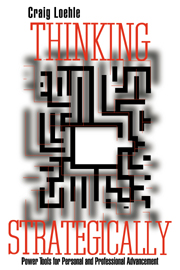Book contents
- Frontmatter
- Contents
- Acknowledgements
- Introduction
- PART 1 Component skills of strategic thinking
- 1 Strategic creativity
- 2 Discovery as a process
- 3 Strategic problem solving
- 4 Reality check
- 5 A matter of style
- 6 Attitude: The inner strategist
- 7 Strategic thinking exercises
- PART 2 Strategic thinking in practice
- Summary: The strategic thinker
- Literature cited
- Index
1 - Strategic creativity
Published online by Cambridge University Press: 24 September 2009
- Frontmatter
- Contents
- Acknowledgements
- Introduction
- PART 1 Component skills of strategic thinking
- 1 Strategic creativity
- 2 Discovery as a process
- 3 Strategic problem solving
- 4 Reality check
- 5 A matter of style
- 6 Attitude: The inner strategist
- 7 Strategic thinking exercises
- PART 2 Strategic thinking in practice
- Summary: The strategic thinker
- Literature cited
- Index
Summary
An essential component of strategic thinking is strategic creativity. Because strategic thinking deals essentially with complex problems, uncertainty, and ambiguity, and involves finding solutions that others have overlooked, it is essential that the practitioner be creative in approach. The standard view of creativity, however, is seriously flawed for application to strategic problem solving. A typical picture of the creative person is the artist or musician, who may have a wild lifestyle and dress in a bizarre fashion. This represents a confusion between the person with a novel lifestyle or a person with flair and someone who is genuinely innovative. Thomas Edison did not wear tie-dye T-shirts. Whereas a wild lifestyle may help or not hinder (though this is debatable) an artist's expression of ideas, this is not the case in the creative application of strategic thinking. In technical and management professions, one needs to be able to think extremely clearly, to be organized, to plan ahead, and to meet deadlines. Wild, magical, and fuzzy thinking are deadly in this context. This in no way means, however, that creativity must be excluded. Far from it. Those professionals who are technically competent but not creative are limited to doing what everyone else already knows how to do. They can run an organization that is already running smoothly, but will not encourage or even allow innovation.
- Type
- Chapter
- Information
- Thinking StrategicallyPower Tools for Personal and Professional Advancement, pp. 9 - 33Publisher: Cambridge University PressPrint publication year: 1996

